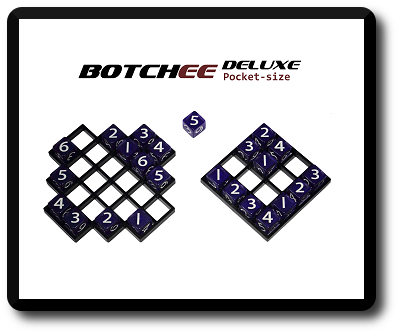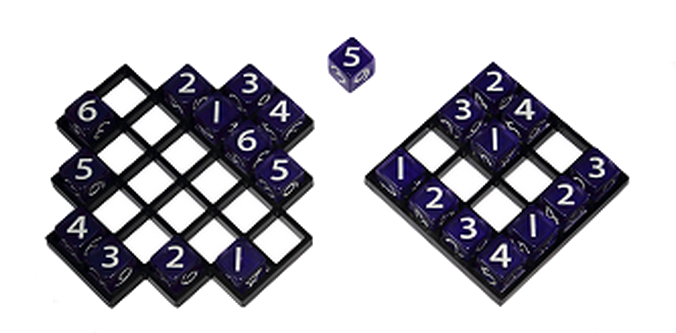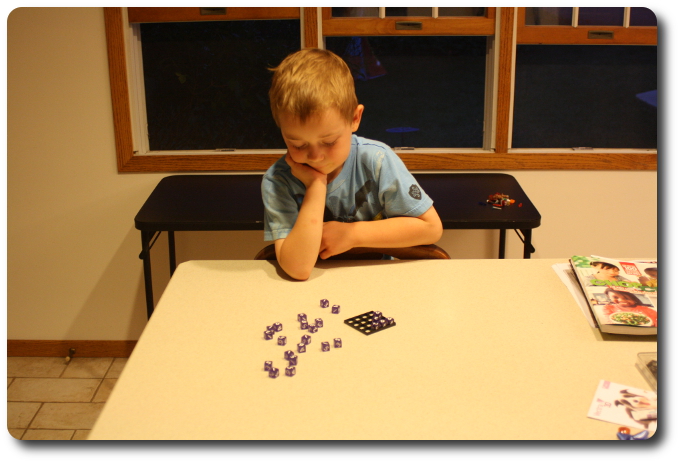
The Basics:
- For ages 5 and up
- For 1 to 6 players
- Variable game length of play
Geek Skills:
- Active Listening & Communication
- Counting & Math
- Logical & Critical Decision Making
- Pattern/Color Matching
Learning Curve:
- Child – Easy
- Adult – Easy
Theme & Narrative:
- None
Endorsements:
- Gamer Geek rejected!
- Parent Geek mixed!
- Child Geek mixed!
Overview
Puzzle solving is a great way to exercise the left and right side of the human brain. A puzzle solver must be analytical and creative at the same time, especially when the puzzle being solved is a race. Flex your mental muscle and find or create patterns in this puzzle game where rolling the dice is optional! With five different ways to play and room to create your own puzzlers, this small pocket game could be a big hit for puzzle game lovers.
Botchee Deluxe, designed by Gary Stout and published by Botchee Games, is comprised of 24 standard six-sided dice, 1 4 x 4 square grid game frame, and 1 “Xtreme” game frame. The entire game fits in a small case making it easy to store and to take with you in your back pocket. Game component quality is excellent with every piece, including the case the game is stored in, being made of solid and very durable plastic. A quality made product, through and through.

“Xtreme” game frame on the left and the 4 x 4 square grid game frame on the right
Playing the Game(s)
Botchee Deluxe comes with 2 game frames that are used to define the playing area. The 4 x 4 square grid game frame is recommended for beginners, lighter play, and for groups of 4 or less players. The “Xtreme” game frame is suggested only for more experienced players, for those who like more complex puzzles, and can comfortably be used by up to 6 players. After selecting one of the two game frames, the player or players need only decide which of the 5 modes of play they would like to use. Each of the 5 modes are summarized here. We encourage you to read the rules found on the game’s website for additional details regarding the different game modes and their various methods of play.
The standard method of determining which player should go first is based on a die roll. The player who rolls the highest number value goes first. Turn order sequence goes clockwise around the table. When it’s a player’s turn, they should take the game frame and rotate it so the dice number values are facing them from their perspective. The dice fit easily into the game frame and will hold the dice in place throughout the entire game playing session.
Note that some games might require the additional use of some paper and a pencil to help keep track of players’ scores. Rolling dice is optional in Region and Point modes of play, but players should feel free to tailor their individual games according to their own likes and dislikes when it comes to randomization.
Pattern
To begin with, each player takes one of the six-sided dice and places it in front of them with a unique number. Each player should have a different number showing. For example, if playing a 3-player game, the dice should be showing number values “1”, “2”, and “3”. These number values do not represent the turn order, but they certainly can. The number showing in front of each player is the number they will use on the dice they play during this game mode.
Players now take turns placing 1 die at a time to the game frame. Depending on the pattern selected, the players will be attempting the following:
- Fic-Fac-Toe: The first player to create a three-in-a-row pattern horizontally, diagonally, or vertically in the game frame wins.
- Fic-Fac-Foe: The first player to create a four-in-a-row pattern horizontally, diagonally, or vertically in the game frame wins.
- Fix-Fac-Fox: The first player to create a 2 x 2 box pattern in addition to creating a three-in-a-row or a four-in-a-row pattern horizontally, diagonally, or vertically in the game frame wins.
- Xic-Xac-Xoe: The first player to create an “X” (using 4 dice) or a “V” (using 5 dice) pattern in the game frame wins.
Region
Region play uses columns and rows in the game frame. A row and a column region extends from one side of the game frame to the other. A box region can only be located in one of the game frame corners. Players take turns selecting one of the dice and placing it in the game frame. The goal is to be the first player to complete a number sequence using one of the 3 regions. Like Sudoku, players cannot place a number that already exists in the region they are playing to. For example, you could not play a “2” to a region that already had a “2”. Additional examples of winning sequences are as follows:
- Row region wins on a “1”, “2”, “3”, and “4” or “2”, “3”, “4” and “5”, or “3”, “4”, “5”, and “6” number sequence
- Column region wins using the same as a row region
- Box region: “1” and “2” on the top row and “3” and “4” on the bottom row, where the pattern is created in one of the game frame corners creating a 2 x 2 grid area with the dice values noted
By default, the first player to create a pattern wins the game. Optionally, 1 point could be awarded to a player when they complete a pattern and the game continues. When the game frame is filled or no other dice can be played legally, the game ends and the player with the most points wins. Certain areas of the game frame could also be declared as the “winning” regions. If a player completes a pattern in a non-winning region, they are awarded another turn, but do not win the game or get a point.
Note that the use of the “Xtreme” game frame with this game mode allows the players to create a number of additional patterns (including diagonal and “X” patterns) during game play. The game rules provide excellent visual examples of both.
Points
Again, numbers are placed in the same style as Sudoku and patterns are built in the same way as the Region game mode noted above. The number of points a player is awarded is equal to the number placed. For example, a “3” would score 3 points. The game ends when the entire game frame is filled or no more legal moves are possible. The player with the most points wins.
Speed
This game mode is all about solving the same Sudoku puzzle using the Region play mode as quickly as possible. A stopwatch or other timekeeping device is necessary to play this game mode.
The game starts with an empty game frame that is placed in front of the player and the dice being rolled to randomize the values show. When the timer is started, the player attempts to create as many legal patterns in the different regions as possible. When the player feels that they can no longer use any of the dice, they call “Time!” Players should determine if it’s permissible to flip the dice values. Players keep track of each others speed and attempt to break their own personal records.
Flips
This game mode is the same as Speed noted above, except the players are attempting to solve the puzzle with as few moves as possible instead of attempting to do it as quickly as possible. Each time a die is moved from the table to the game frame, it counts as one move. When a die is flipped to a new number, it’s considered a move, as well. The player who completes the puzzle in as few moves as possible is the winner.
We have only summarized the puzzles and the game play here. To learn more about Botchee Deluxe and read the full game rules, visit the game’s website.
Prediction
Puzzle games can be difficult to predict. They are designed, by default, to challenge and often times have different levels of difficulty. Most of the time, puzzle games are meant to be played solo, but Botchee Deluxe allows more than 1 player to join in on the puzzle solving fun. This introduction of a more social style of play should make the game more appealing to those who usually don’t care for solitaire or puzzle games.
I really cannot predict how this game will be received other than to state that the players who I know enjoy puzzle games will enjoy Botchee Deluxe and those who don’t won’t. Very simple. But from a group perspective (Child, Parent, and Gamer Geek), I have simply no idea. Well, that’s not completely accurate. I know which groups usually enjoy these types of games from a more general perspective. The Child and Parent Geeks should enjoy it somewhat, but I have no doubt the majority of Gamer Geeks will reject it.
The rules included to this game are confusing. They read like you should already know how to play the game. Lack of visual examples and more indepth game explanation makes understanding some of the game play modes difficult at best. In fact, I’m not 100% certain we even played the games right based on our interpretation of the rules. Not that any of it matters, mind you. As long as everyone agrees to “how” the game should be played, there shouldn’t be any problems. Additionally, players should feel free to adjust and add to the rules if they like. In this light, the game rules are not so much incomplete or confusing, but intentionally open-ended to allow players to interpret how the puzzles should be solved. That will be well received by some and very much disliked by others. Especially the “rules lawyers” who need everything spelled out for them and clearly documented.
None of the puzzle games are difficult to learn and should be playable as well as solvable by Child Geeks. Simple arithmetic and number recognition is all that is needed to play the games. The games that require the player to do things quickly should be avoided if playing with younger or less experienced players.
After I explained the different game modes to my two oldest Child Geeks, I asked them their thoughts on Botchee Deluxe so far.
“Puzzle games are not really my thing, but I’ll give it a shot.” ~ Liam (age 8)
“So I can play this with you or by myself? Cool!” ~ Nyhus (age 6)
What we see here are two different Child Geeks starting to come into their own and presenting their personal likes and dislikes when it comes to game types and game playing styles. My 8-year-old prefers action and resource management games with 2 or more players, where my 6-year-old prefers the quiet and more intense play of puzzle games that can be played solo. Botchee Deluxe provides both. Let’s see if it appeals or repels our players.
Final Word
The Child Geeks were mixed when it came to their final approval rating for Botchee Deluxe. As predicted, the Child Geeks who enjoyed or showed an interest in numbers, math, pattern matching, or puzzle solving liked the game. Those who did not or felt the puzzles were too hard or “boring” (according to some of the Child Geeks), didn’t care for the game at all. Regardless of how the Child Geeks felt towards the game, it was clear that it challenged all of them. Some of the more quiet Child Geeks enjoyed playing the game solo, but most of the time the game was shared with friends and family.

My 6-year-old and I enjoy a quiet game of Tic-Tac-Toe, Botchee Deluxe style, before bedtime
The Parent Geeks were also mixed when it came to the game. Some of the Parent Geeks saw Botchee Deluxe as a learning tool and approved it based on its perceived educational merits. But overall, the game found mixed approval ratings within the Parent Geek group based on its “fun value”. Some Parent Geeks thought Botchee Deluxe did a great job challenging the player and engaging them in worthwhile mental and mathematical exercises. Some of the Parent Geeks thought the puzzles and games were so-so at best. In the end, the Parent Geeks were not displeased or elated with Botchee Deluxe.
The majority of Gamer Geeks all voted to reject the game. According to one Gamer Geek, “Some interesting ideas, but this is not a game so much as it is a puzzle that uses dice. I can’t approve something like this at the Gamer Geek’s level.” Only one Gamer Geek found the games and the puzzles to be enjoyable and engaging enough to lead him to believe Botchee Deluxe was a Gamer Geek’s game. According to him, “I was challenged and liked what the game was about. That’s good enough for me!” But not nearly enough to get the game the Gamer Geeks’ approval, however.
Overall, I didn’t find anything about Botchee Deluxe to be particularly appealing or off-putting. It simply is what it is. Which left me feeling pretty “meh” about it. Nothing about the game sizzles or pops. Even our puzzle loving gamers, be they Child, Parent, or Gamer Geeks, thought the level of challenge was moderate most of the time and the game’s delivery was forgettable. But let’s not dismiss the game so quickly. Puzzle games are a niche corner of our hobby and a tricky one to target. You must balance “fun play” with “focused problem solving”. That can be difficult, especially when the puzzle game has no theme or narrative to fall back on. So let’s take Botchee Deluxe for what it is: a very portable and easy to use puzzle solving game. As such is the case, Botchee Deluxe succeeds. What it lacks is wide appeal, but for those looking for a highly portable dice puzzle game, it’s sure to please and amuse to various degrees.
This game was given to Father Geek as a review copy. Father Geek was not paid, bribed, wined, dined, or threatened in vain hopes of influencing this review. Such is the statuesque and legendary integrity of Father Geek.



